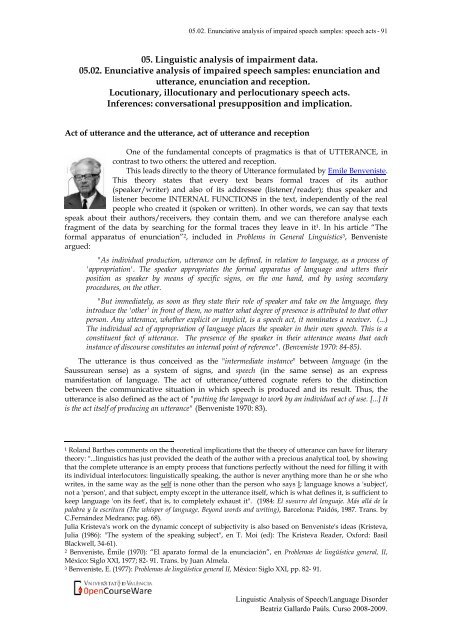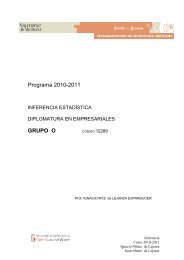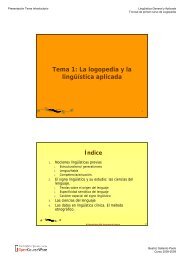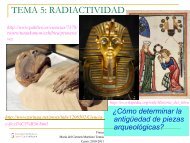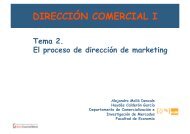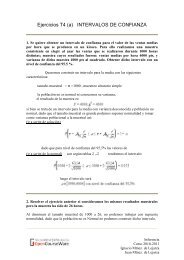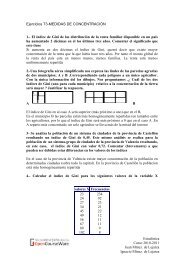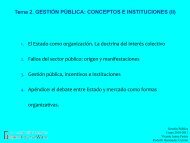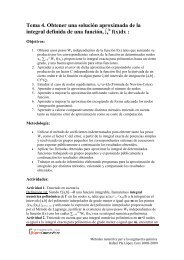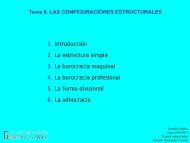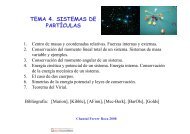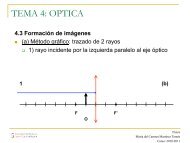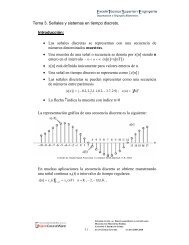Act of utterance and the utterance, act of utterance - OCW de la ...
Act of utterance and the utterance, act of utterance - OCW de la ...
Act of utterance and the utterance, act of utterance - OCW de la ...
- No tags were found...
You also want an ePaper? Increase the reach of your titles
YUMPU automatically turns print PDFs into web optimized ePapers that Google loves.
05.02. Enunciative analysis <strong>of</strong> impaired speech samples: speech <strong>act</strong>s - 9105. Linguistic analysis <strong>of</strong> impairment data.05.02. Enunciative analysis <strong>of</strong> impaired speech samples: enunciation <strong>and</strong><strong>utterance</strong>, enunciation <strong>and</strong> reception.Locutionary, illocutionary <strong>and</strong> perlocutionary speech <strong>act</strong>s.Inferences: conversational presupposition <strong>and</strong> implication.<strong>Act</strong> <strong>of</strong> <strong>utterance</strong> <strong>and</strong> <strong>the</strong> <strong>utterance</strong>, <strong>act</strong> <strong>of</strong> <strong>utterance</strong> <strong>and</strong> receptionOne <strong>of</strong> <strong>the</strong> fundamental concepts <strong>of</strong> pragmatics is that <strong>of</strong> UTTERANCE, incontrast to two o<strong>the</strong>rs: <strong>the</strong> uttered <strong>and</strong> reception.This leads directly to <strong>the</strong> <strong>the</strong>ory <strong>of</strong> Utterance formu<strong>la</strong>ted by Emile Benveniste.This <strong>the</strong>ory states that every text bears formal traces <strong>of</strong> its author(speaker/writer) <strong>and</strong> also <strong>of</strong> its addressee (listener/rea<strong>de</strong>r); thus speaker <strong>and</strong>listener become INTERNAL FUNCTIONS in <strong>the</strong> text, in<strong>de</strong>pen<strong>de</strong>ntly <strong>of</strong> <strong>the</strong> realpeople who created it (spoken or written). In o<strong>the</strong>r words, we can say that textsspeak about <strong>the</strong>ir authors/receivers, <strong>the</strong>y contain <strong>the</strong>m, <strong>and</strong> we can <strong>the</strong>refore analyse eachfragment <strong>of</strong> <strong>the</strong> data by searching for <strong>the</strong> formal traces <strong>the</strong>y leave in it 1 . In his article “Theformal apparatus <strong>of</strong> enunciation” 2 , inclu<strong>de</strong>d in Problems in General Linguistics 3 , Benvenisteargued:"As individual production, <strong>utterance</strong> can be <strong>de</strong>fined, in re<strong>la</strong>tion to <strong>la</strong>nguage, as a process <strong>of</strong>'appropriation'. The speaker appropriates <strong>the</strong> formal apparatus <strong>of</strong> <strong>la</strong>nguage <strong>and</strong> utters <strong>the</strong>irposition as speaker by means <strong>of</strong> specific signs, on <strong>the</strong> one h<strong>and</strong>, <strong>and</strong> by using secondaryprocedures, on <strong>the</strong> o<strong>the</strong>r."But immediately, as soon as <strong>the</strong>y state <strong>the</strong>ir role <strong>of</strong> speaker <strong>and</strong> take on <strong>the</strong> <strong>la</strong>nguage, <strong>the</strong>yintroduce <strong>the</strong> 'o<strong>the</strong>r' in front <strong>of</strong> <strong>the</strong>m, no matter what <strong>de</strong>gree <strong>of</strong> presence is attributed to that o<strong>the</strong>rperson. Any <strong>utterance</strong>, whe<strong>the</strong>r explicit or implicit, is a speech <strong>act</strong>, it nominates a receiver. (...)The individual <strong>act</strong> <strong>of</strong> appropriation <strong>of</strong> <strong>la</strong>nguage p<strong>la</strong>ces <strong>the</strong> speaker in <strong>the</strong>ir own speech. This is aconstituent f<strong>act</strong> <strong>of</strong> <strong>utterance</strong>. The presence <strong>of</strong> <strong>the</strong> speaker in <strong>the</strong>ir <strong>utterance</strong> means that eachinstance <strong>of</strong> discourse constitutes an internal point <strong>of</strong> reference". (Benveniste 1970: 84-85).The <strong>utterance</strong> is thus conceived as <strong>the</strong> "intermediate instance" between <strong>la</strong>nguage (in <strong>the</strong>Saussurean sense) as a system <strong>of</strong> signs, <strong>and</strong> speech (in <strong>the</strong> same sense) as an expressmanifestation <strong>of</strong> <strong>la</strong>nguage. The <strong>act</strong> <strong>of</strong> <strong>utterance</strong>/uttered cognate refers to <strong>the</strong> distinctionbetween <strong>the</strong> communicative situation in which speech is produced <strong>and</strong> its result. Thus, <strong>the</strong><strong>utterance</strong> is also <strong>de</strong>fined as <strong>the</strong> <strong>act</strong> <strong>of</strong> "putting <strong>the</strong> <strong>la</strong>nguage to work by an individual <strong>act</strong> <strong>of</strong> use. [...] Itis <strong>the</strong> <strong>act</strong> itself <strong>of</strong> producing an <strong>utterance</strong>" (Benveniste 1970: 83).1 Rol<strong>and</strong> Bar<strong>the</strong>s comments on <strong>the</strong> <strong>the</strong>oretical implications that <strong>the</strong> <strong>the</strong>ory <strong>of</strong> <strong>utterance</strong> can have for literary<strong>the</strong>ory: "...linguistics has just provi<strong>de</strong>d <strong>the</strong> <strong>de</strong>ath <strong>of</strong> <strong>the</strong> author with a precious analytical tool, by showingthat <strong>the</strong> complete <strong>utterance</strong> is an empty process that functions perfectly without <strong>the</strong> need for filling it withits individual interlocutors: linguistically speaking, <strong>the</strong> author is never anything more than he or she whowrites, in <strong>the</strong> same way as <strong>the</strong> self is none o<strong>the</strong>r than <strong>the</strong> person who says I; <strong>la</strong>nguage knows a 'subject',not a 'person', <strong>and</strong> that subject, empty except in <strong>the</strong> <strong>utterance</strong> itself, which is what <strong>de</strong>fines it, is sufficient tokeep <strong>la</strong>nguage 'on its feet', that is, to completely exhaust it". (1984: El susurro <strong>de</strong>l lenguaje. Más allá <strong>de</strong> <strong>la</strong>pa<strong>la</strong>bra y <strong>la</strong> escritura (The whisper <strong>of</strong> <strong>la</strong>nguage. Beyond words <strong>and</strong> writing), Barcelona: Paidós, 1987. Trans. byC.Fernán<strong>de</strong>z Medrano; pag. 68).Julia Kristeva's work on <strong>the</strong> dynamic concept <strong>of</strong> subjectivity is also based on Benveniste's i<strong>de</strong>as (Kristeva,Julia (1986): "The system <strong>of</strong> <strong>the</strong> speaking subject", en T. Moi (ed): The Kristeva Rea<strong>de</strong>r, Oxford: BasilB<strong>la</strong>ckwell, 34-61).2 Benveniste, Émile (1970): “El aparato formal <strong>de</strong> <strong>la</strong> enunciación”, en Problemas <strong>de</strong> lingüística general, II,México: Siglo XXI, 1977; 82- 91. Trans. by Juan Alme<strong>la</strong>.3 Benveniste, E. (1977): Problemas <strong>de</strong> lingüística general II, México: Siglo XXI, pp. 82- 91.Linguistic Analysis <strong>of</strong> Speech/Language Disor<strong>de</strong>rBeatriz Gal<strong>la</strong>rdo Paúls. Curso 2008-2009.
05.02. Enunciative analysis <strong>of</strong> impaired speech samples: speech <strong>act</strong>s - 93Of <strong>the</strong>se, <strong>the</strong> first has become a focus <strong>of</strong> interest for pragmatics. According to Levinson's<strong>de</strong>finition (1983: 227) 7 <strong>the</strong> illocutionary <strong>act</strong> "is what is directly achieved by <strong>the</strong> conventional forceassociated with <strong>the</strong> issuance <strong>of</strong> a certain kind <strong>of</strong> <strong>utterance</strong> in accord with a conventional procedure". Thisforce is <strong>the</strong> ILLOCUTIONARY FORCE <strong>of</strong> <strong>the</strong> <strong>utterance</strong>: “<strong>the</strong> recognition <strong>of</strong> <strong>the</strong> speaker's purpose inuttering that X” (McLaughlin 1984:63) 8 .The typology <strong>of</strong> illocutionary <strong>act</strong>s put forward by Austin (1962: 148 ss) recognises:• VERDICTIVES: give a verdict.• EXERCITIVES: exercising powers, rights or influence.• COMMISSIVES: commit <strong>the</strong> speaker to something, whe<strong>the</strong>r to a future <strong>act</strong>ion(promise) or a to statement.• BEHABITIVES: a heterogeneous group re<strong>la</strong>ted to attitu<strong>de</strong>s <strong>and</strong> social behaviour.• EXPOSITIVES: refer to <strong>the</strong> speaker's position in <strong>the</strong> course <strong>of</strong> a discussion orconversation: answer, argue, conce<strong>de</strong>, accept, admit, etc.As you can see, since Austin <strong>the</strong> various types <strong>of</strong> speech <strong>act</strong> have been linked with differentverbs, which has sometimes led to methodological confusion. It should be remembered thatAustin's starting point was <strong>the</strong> i<strong>de</strong>ntification <strong>of</strong> two types <strong>of</strong> <strong>utterance</strong>:- constative, which are true or false (llueve - it is raining),- <strong>and</strong> performative, or executive, that just by being spoken involve an <strong>act</strong>ion ad<strong>de</strong>d to <strong>the</strong>speech <strong>act</strong>, <strong>and</strong> that are not susceptible to being <strong>de</strong>c<strong>la</strong>red true or false. Utterances such as Te<strong>de</strong>c<strong>la</strong>ro <strong>la</strong> guerra (I <strong>de</strong>c<strong>la</strong>re war on you), Te juro que no he sido yo (I swear that it was not me), or Teprometo que lo haré (I promise that I will do it). Later studies have come to <strong>the</strong> conclusion that everysentence involves an <strong>act</strong> <strong>of</strong> this kind, although it may be implicit: "Te digo que" (I tell you that),"supongo que" (I suppose that), "pregunto si" (I ask if), etc. The type <strong>of</strong> verb that utters <strong>the</strong>illocutionary <strong>act</strong>ion has been called PERFORMATIVE VERB (for Austin, Explicit Performative,as opposed to <strong>the</strong> Primary Performative, 1962: 83), but it should not be confused with a type <strong>of</strong><strong>act</strong>.Austin endows performative <strong>utterance</strong>s with four features:• <strong>the</strong>y correspond grammatically to a <strong>de</strong>c<strong>la</strong>rative sentence• <strong>the</strong>y are in 1st person indicative• <strong>the</strong>y are not meaningless expressions• <strong>the</strong>y are nei<strong>the</strong>r true nor false, but ra<strong>the</strong>r a<strong>de</strong>quate or ina<strong>de</strong>quate.7 Levinson, Stephen (1983): La Pragmática (Pragmatics). Barcelona: Tei<strong>de</strong>, 1987. Trans. by África Rubiés.8 McLaughlin, Margaret (1984): Conversation: how talk is organized, Beverly Hills: Sage Pub.Linguistic Analysis <strong>of</strong> Speech/Language Disor<strong>de</strong>rBeatriz Gal<strong>la</strong>rdo Paúls. Curso 2008-2009.
05.02. Enunciative analysis <strong>of</strong> impaired speech samples: speech <strong>act</strong>s - 94By Michael Stubbs (1987): Análisis <strong>de</strong>ldiscurso (Discourse analysis), Madrid,Alianza, p. 153 ss"The basic i<strong>de</strong>a, <strong>de</strong>veloped by J. L. Austin in1955 in his Harvard University c<strong>la</strong>sses, isthat words are <strong>act</strong>ions. Certain <strong>act</strong>ions canonly be carried out through <strong>la</strong>nguage(apologising, for example) <strong>and</strong> o<strong>the</strong>rs canbe performed verbally <strong>and</strong> non-verbally(threaten, for example). Moreover, as soonas we begin to study how <strong>la</strong>nguage is usedin social inter<strong>act</strong>ion, it becomes evi<strong>de</strong>nt thatcommunication is impossible if <strong>the</strong> speaker<strong>and</strong> <strong>the</strong> listener do not share certainknowledge <strong>and</strong> assumptions.(...) Austin's original i<strong>de</strong>a was that to stateor <strong>de</strong>scribe is only one <strong>of</strong> <strong>la</strong>nguage'sfunctions. He argued that statements(constatives, in Austin's terms) do not evenhave a privileged position. Although <strong>the</strong>yare usually thought to be basic, adults donot generally make unsolicited statementsor <strong>de</strong>scribe <strong>the</strong> world. The basic distinctionbetween constatives <strong>and</strong> performatives isthat only <strong>the</strong> former can be true or false.Performatives are used to perform <strong>act</strong>ions,so <strong>the</strong>re is no sense in questioning <strong>the</strong>irtruthfulness. For example, if A says: Ipromise to come, it makes no sense for B tosay: That isn't true.(...) Austin's original distinction betweenconstative <strong>and</strong> performative is erroneous,as Austin himself recognised, because <strong>the</strong>same statement can be affirmed, negated orasked, be a remin<strong>de</strong>r to someone else, usedas a comp<strong>la</strong>int, etc. That is, <strong>the</strong> statement isa speech <strong>act</strong> like any o<strong>the</strong>r.(...) From this observation, Austin<strong>de</strong>veloped his general <strong>the</strong>ory <strong>of</strong> speech <strong>act</strong>s.Utterances can carry out three types <strong>of</strong> <strong>act</strong>.The locutionary <strong>act</strong> is <strong>the</strong> <strong>act</strong> <strong>of</strong> sayingsomething, <strong>of</strong> producing a series <strong>of</strong> soundsthat have meaning. This is <strong>the</strong> aspect <strong>of</strong><strong>la</strong>nguage that linguistics has traditionallybeen interested in. The perlocutionary <strong>act</strong>produces an effect in listeners. Persuasion isa perlocutionary <strong>act</strong>: you cannot persua<strong>de</strong>someone <strong>of</strong> something by simply saying Ipersua<strong>de</strong> you. Simi<strong>la</strong>r examples would beconvince, disturb, frighten <strong>and</strong> entertain.The effect <strong>of</strong> <strong>la</strong>nguage on <strong>the</strong> audience hastraditionally been <strong>the</strong> field <strong>of</strong> rhetoric. Theillocutionary <strong>act</strong> is carried out whensomething is said, for example: bet,promise, <strong>de</strong>ny <strong>and</strong> or<strong>de</strong>r. Some verbs usedto <strong>de</strong>fine illocutionary <strong>act</strong>s can be usedperformatively. For example, to say I <strong>de</strong>ny Xis to <strong>de</strong>ny it.Linguistic Analysis <strong>of</strong> Speech/Language Disor<strong>de</strong>rBeatriz Gal<strong>la</strong>rdo Paúls. Curso 2008-2009.
05.02. Enunciative analysis <strong>of</strong> impaired speech samples: speech <strong>act</strong>s - 96MainelementDimension <strong>of</strong> <strong>the</strong> speech<strong>act</strong>ValueLinguisticcomponentSpeakerILLOCUTIONARYIllocutionary <strong>act</strong>Having certain communicative intention("illocutional force")PragmaticsMessageLOCUTIONARYEnunciative <strong>act</strong> Making sounds <strong>of</strong> <strong>the</strong> <strong>la</strong>nguage PhonologyLexicalPropositional <strong>act</strong>Organising <strong>the</strong>se sounds into a chain <strong>of</strong>meaningSemanticMorphosyntaxReceiverPERLOCUTIONARYPerlocutionary <strong>act</strong>Effect achieved in <strong>the</strong> receiverWhen we analyse data from speakers with motor aphasias, char<strong>act</strong>erised by anomie <strong>and</strong>articu<strong>la</strong>tory failure, we can see, however, that enunciative <strong>act</strong>s, <strong>de</strong>prived <strong>of</strong> propositionalcontent, fulfil an essential dialogic function. In <strong>the</strong>se cases, we refer to speech <strong>act</strong>s <strong>act</strong>ivatinginferences, as <strong>the</strong>y enable <strong>the</strong> speaker to state <strong>the</strong>ir proposals <strong>of</strong> interpretation.Type <strong>of</strong> <strong>act</strong> Searle's <strong>de</strong>finition ExamplesRepresentative The <strong>act</strong> refers to a certain state <strong>of</strong> things assertions, affirmations, beliefsDirectiveExpressiveCommissiveDec<strong>la</strong>rativeThe <strong>act</strong> provokes certain behaviour in <strong>the</strong> listenerThe <strong>act</strong> expresses a pyschological stateThe speaker commits to performing a future <strong>act</strong>The <strong>utterance</strong> <strong>of</strong> a particu<strong>la</strong>r enunciation in certain social <strong>and</strong>cultural conditions provokes certain consequences in thatcontextquestions, suggestions, invitations,calls, requestscongratu<strong>la</strong>tions, thanks,condolencesdares, bets, oaths, promises,challengesbaptisms, <strong>de</strong>c<strong>la</strong>rations <strong>of</strong> war,inaugurations, signing contr<strong>act</strong>sAs regards <strong>the</strong> effective performance <strong>of</strong> ILLOCUTIONARY SPEECH ACTS, we find that it is possiblefor speakers with aphasia. The difficulties, as we have pointed out above, affect <strong>the</strong> locutionary<strong>and</strong> propositional dimension, in which grammar is involved (Gal<strong>la</strong>rdo 2005). If we accept <strong>the</strong>c<strong>la</strong>ssic c<strong>la</strong>ssification proposed by J. Searle (1976), we see that <strong>the</strong> PerLA corpus provi<strong>de</strong>s cases <strong>of</strong>all kinds <strong>of</strong> performance except for <strong>the</strong> <strong>de</strong>c<strong>la</strong>rative <strong>act</strong>, which is <strong>of</strong> necessity linked to differentsocial <strong>and</strong> communicative contexts to those <strong>of</strong> <strong>the</strong> recordings (although <strong>the</strong> informed consentthat many <strong>of</strong> our subjects have been able to sign in f<strong>act</strong> shows <strong>the</strong>se <strong>de</strong>c<strong>la</strong>rative features).Linguistic Analysis <strong>of</strong> Speech Language Disor<strong>de</strong>rsBeatriz Gal<strong>la</strong>rdo Paúls. Course 2008-2009.
05.02. Enunciative analysis <strong>of</strong> impaired speech samples: speech <strong>act</strong>s - 97These speech <strong>act</strong>s, which Searle groups according to <strong>the</strong>ir illocutional force, can also bec<strong>la</strong>ssified according to <strong>the</strong> p<strong>la</strong>ce <strong>the</strong>y typically occupy within <strong>the</strong> intervention, as we should notlose sight <strong>of</strong> <strong>the</strong> f<strong>act</strong> that <strong>the</strong>y are always used effectively in inter<strong>act</strong>ive, dialogic contexts. This iswhy, in our view, it is important to consi<strong>de</strong>r two basic types <strong>of</strong> speech <strong>act</strong> according to <strong>the</strong>irrelevance in <strong>the</strong> turn taking system:• dynamic or linking <strong>act</strong>s, that are effectively used to regu<strong>la</strong>te turn taking; <strong>the</strong>y can beretro-<strong>act</strong>ive or projective, according to <strong>the</strong>ir occurrence <strong>the</strong>y refer to ei<strong>the</strong>r <strong>the</strong>previous or <strong>the</strong> next turn.• static or constitutive <strong>act</strong>s: limited to <strong>de</strong>velopment <strong>of</strong> <strong>the</strong> topic whilst maintaining <strong>the</strong>turn pattern.In addition, <strong>the</strong>re are some linguistic elements that seem to specialise in producing dynamicspeech <strong>act</strong>s:• Retro-<strong>act</strong>ive linking turns: prefaces (marking <strong>the</strong> re<strong>la</strong>tion with <strong>the</strong> previousintervention: markers, prefaces, erroneous position markers, disjunctive markers,contrast markers) <strong>and</strong> restarts (when <strong>the</strong> speaker interrupts <strong>the</strong>mselves at <strong>the</strong>beginning <strong>of</strong> <strong>the</strong> turn, used for getting attention).• Projective linking turns: signal <strong>the</strong> end <strong>of</strong> <strong>the</strong> intervention <strong>and</strong> turn h<strong>and</strong>over: <strong>the</strong>yare basically tag questions (“¿no?”, “¿eh?”, “¿sabes?”) <strong>and</strong> extension phrases (“y eso", “ynada”).Speakers with motor aphasia tend to over-exploit some <strong>of</strong> <strong>the</strong>se structures, in or<strong>de</strong>r to check<strong>the</strong>y are being un<strong>de</strong>rstood by <strong>the</strong>ir conversational partner, <strong>and</strong> this enables <strong>the</strong>m to keep <strong>the</strong>irturn <strong>de</strong>spite <strong>the</strong>ir possible slowness/difficulty.* * * *Toge<strong>the</strong>r with <strong>the</strong> typology <strong>of</strong> speech <strong>act</strong>s according to <strong>the</strong>ir illocutional force <strong>and</strong> <strong>the</strong>ir p<strong>la</strong>ce in<strong>the</strong> intervention, <strong>the</strong>re is a third c<strong>la</strong>ssification that is relevant to clinical pragmatics, <strong>de</strong>alingwith <strong>the</strong> conversational level at which <strong>the</strong> speech <strong>act</strong> is situated. We can thus differentiatebetween:• substantive <strong>act</strong>s (that are <strong>the</strong>mselves <strong>the</strong> <strong>utterance</strong> or message) <strong>and</strong>• control or metacommunicative <strong>act</strong>s (that refer to aspects <strong>of</strong> <strong>the</strong> <strong>utterance</strong>).When verbal <strong>act</strong>ivity itself becomes <strong>the</strong> object <strong>of</strong> a communicative <strong>act</strong>, as occurs in <strong>la</strong>nguage<strong>the</strong>rapy sessions, this distinction is relevant for <strong>the</strong> speech <strong>the</strong>rapist, as <strong>the</strong>ir intervention reliesprecisely on control <strong>act</strong>s. From <strong>the</strong> conversational point <strong>of</strong> view, control <strong>act</strong>s are useful fortriggering rectification exchanges <strong>and</strong>, in general, dialogic management metacommunicativebehaviours. In this sense, <strong>and</strong> within what we are calling control <strong>act</strong>s, Carolyn Letts (1985) 10distinguishes two basic speech <strong>act</strong>s in speech <strong>the</strong>rapists' <strong>act</strong>ivity:1. Organisers:1.1. start <strong>act</strong>ivities (limiting <strong>and</strong> guiding markers: “bueno”, “bien”, “a ver”, “qué iba a<strong>de</strong>cir yo”).1.2. ensure <strong>the</strong> <strong>act</strong>ivity flows smoothly: attention grabbers (“oye”, “mira una cosa”),behaviour modifiers (“espera, no te levantes aún”), testers <strong>of</strong> un<strong>de</strong>rst<strong>and</strong>ing(“¿no?”, “¿<strong>de</strong> acuerdo?”, “¿lo entien<strong>de</strong>s?”), repetition requests (“¿perdona?”, “¿me lorepites?”)10 Letts, Carolyn (1985): “Linguistic inter<strong>act</strong>ion in <strong>the</strong> clinic. How do <strong>the</strong>rapists do <strong>the</strong>rapy?”, ChildLanguage Teaching <strong>and</strong> Therapy 1(3), 321-331.Linguistic Analysis <strong>of</strong> Speech Language Disor<strong>de</strong>rsBeatriz Gal<strong>la</strong>rdo Paúls. Course 2008-2009.
05.02. Enunciative analysis <strong>of</strong> impaired speech samples: speech <strong>act</strong>s - 982. Continuers:2.1. trigger concrete replies: directive <strong>act</strong>s, questions, signs2.2. agreement check behaviours (“muy bien”, “así, eso es”)2.3. give general information (glossing, paraphrasing).<strong>Act</strong>s <strong>of</strong> control inclu<strong>de</strong> draft <strong>act</strong>s, which involve a test or tentative attempt to elicit a certainspeech <strong>act</strong>. The speaker does not gain access to a certain substantive <strong>act</strong> <strong>and</strong> goes through aprevious itinerary <strong>of</strong> draft <strong>act</strong>s that pepper <strong>the</strong> intervention as though <strong>the</strong>y were a succession <strong>of</strong>filled pauses (this is precisely one <strong>of</strong> <strong>the</strong> behaviours that Crockford <strong>and</strong> Lesser term editingbehaviours in <strong>the</strong>ir Quantification <strong>of</strong> Conversational Behaviours protocol, QCB). Along with <strong>the</strong>speaker's real inability to silence <strong>the</strong>se test <strong>act</strong>s (that is, to relegate <strong>the</strong>m to <strong>the</strong> status <strong>of</strong> hid<strong>de</strong>n<strong>utterance</strong>) is <strong>the</strong> issue <strong>of</strong> keeping <strong>the</strong> turn while managing to articu<strong>la</strong>te <strong>the</strong> interventioneffectively. As seen in <strong>the</strong> discussion <strong>of</strong> beat regu<strong>la</strong>tors, repeated movement transmits <strong>the</strong> sense<strong>of</strong> <strong>act</strong>ivity to <strong>the</strong> conversational partner <strong>and</strong> thus avoids interruption.* * * *The level <strong>of</strong> speech <strong>act</strong>s has been studied quite thoroughly in situations <strong>of</strong> impairment 11 , but <strong>the</strong>distinction between <strong>the</strong> enunciative <strong>and</strong> <strong>the</strong> propositional dimension has not always been takeninto account. Thus, when Soroker et al. (2005) <strong>de</strong>fen<strong>de</strong>d <strong>the</strong> <strong>la</strong>teralisation <strong>of</strong> basic speech <strong>act</strong>s in<strong>the</strong> left hemisphere, <strong>the</strong>y were <strong>de</strong>fending <strong>the</strong>reality <strong>of</strong> <strong>the</strong> locutional <strong>and</strong> propositionalproduction <strong>of</strong> illocutional speech <strong>act</strong>s, that is,to <strong>the</strong>ir grammatical dimension. Basic Speech<strong>Act</strong>s (BSA) are those that are indispensablefor any competent speaker, <strong>and</strong> that alsosustain <strong>the</strong> effective production <strong>of</strong> o<strong>the</strong>rs:affirmation, question, request <strong>and</strong> or<strong>de</strong>r. Thestarting-point in <strong>the</strong>ir study is <strong>the</strong> findingthat:“Both left <strong>and</strong> right cerebral damage producedsignificant impairments re<strong>la</strong>tive to normalcontrols, <strong>and</strong> left brain damaged patientsperformed worse than patients with right-si<strong>de</strong>dlesions. This finding argues against <strong>the</strong> commonconjecture that <strong>the</strong> right hemisphere <strong>of</strong> mostright-h<strong>and</strong>ers p<strong>la</strong>ys a dominant role in natural<strong>la</strong>nguage pragmatics” (2005: 214).This statement forgets that pragmatics usesspeech <strong>act</strong>s based on grammar. Althoughspeakers with left-hemisphere injury fail torealise <strong>the</strong>se <strong>act</strong>s verbally (in <strong>the</strong>ir"grammatical" dimension: locutionary,propositional, enunciative) <strong>the</strong>y can in f<strong>act</strong> realise <strong>the</strong>m by means <strong>of</strong> gestural <strong>and</strong> prosodicco<strong>de</strong>s; it is <strong>the</strong>refore possible to say that illocutiveness is preserved <strong>de</strong>spite <strong>the</strong> left hemispherelesion.11 Soroker Nachum; Kasher, Asa; Giora, Rachel; Batori, Gi<strong>la</strong>; Corn, Cecilia; Gil, Mali / Zai<strong>de</strong>l, Eran(2005): “Processing <strong>of</strong> basic speech <strong>act</strong>s following localized brain damage: A new light in <strong>the</strong>neuroanatomy <strong>of</strong> <strong>la</strong>nguage”, Brain <strong>and</strong> Cognition, 57, pp. 214-217.Linguistic Analysis <strong>of</strong> Speech Language Disor<strong>de</strong>rsBeatriz Gal<strong>la</strong>rdo Paúls. Course 2008-2009.
05.02. Enunciative analysis <strong>of</strong> impaired speech samples: speech <strong>act</strong>s - 99The study by Soroker et al. (2005) <strong>de</strong>fends a direct association between certain left-hemisphere(LH) locations (those <strong>of</strong> BSA), arguing that <strong>the</strong> right hemisphere (RH) only takes partoccasionally in some cases <strong>of</strong> requests. It should be pointed out, however, that <strong>the</strong>y are notstrictly speaking about illocutiveness (<strong>of</strong> pragmatics) but about <strong>the</strong> morphosyntaxis <strong>and</strong>semantics required to carry out this communicative intent. As no item <strong>of</strong> those used is<strong>de</strong>scribed, we cannot know ex<strong>act</strong>ly what relevance <strong>the</strong> results have.In any case, <strong>the</strong> final statement that “<strong>the</strong>re is systematic localization <strong>of</strong> BSAs in <strong>the</strong> LH but not in <strong>the</strong>RH” should be taken in a re<strong>la</strong>tive sense, to <strong>the</strong> extent that <strong>the</strong> items assessed (basic illocutionary<strong>act</strong>s) <strong>de</strong>pend on semantics <strong>and</strong> morphosyntaxis for <strong>the</strong>ir execution, toge<strong>the</strong>r with <strong>the</strong> f<strong>act</strong> that<strong>the</strong> speakers assessed use <strong>the</strong> grammar <strong>of</strong> a specific <strong>la</strong>nguage. The methodological <strong>de</strong>scriptionfor <strong>the</strong> study does not say explicitly 12 , but we can <strong>de</strong>duce that it <strong>de</strong>als with Hebrew speakersbecause it is stated that <strong>the</strong> subjects (21 with right hemisphere injury <strong>and</strong> 31 with lef<strong>the</strong>misphere injury) were assessed using Hebrew versions <strong>of</strong> <strong>the</strong> Western Battery (Kertesz) <strong>and</strong><strong>of</strong> <strong>the</strong> Grammatical Comprehension Test (Curtiss). These are, <strong>the</strong>n, speakers <strong>of</strong> a non-tonal,fusioning <strong>la</strong>nguage, with a word or<strong>de</strong>r that is not particu<strong>la</strong>rly markedly Verb-Subject-Objectbut quite flexible, <strong>and</strong> in which <strong>the</strong>re is a notable use <strong>of</strong> triliteral roots typical <strong>of</strong> Semitic<strong>la</strong>nguages, using concatenated morphemes (ad<strong>de</strong>d) but also with segmental changes (a change<strong>of</strong> vowels in some verbal forms can lead to morphological change). It can be said that <strong>the</strong> brains<strong>of</strong> speakers <strong>of</strong> tonal <strong>la</strong>nguages (both iso<strong>la</strong>ting <strong>and</strong> fusioning, that is with lexical ormorphological use <strong>of</strong> <strong>the</strong> tonal change) can show o<strong>the</strong>r uses <strong>of</strong> <strong>the</strong>ir respective hemispheres...* * * *In short, when analysing <strong>the</strong> enunciative dimension <strong>of</strong> speech <strong>act</strong>s in data from impairedspeakers, we will be analysing <strong>the</strong> following categories:• PROPOSITIONAL ACTS [AP]: that is, those <strong>act</strong>s that possess a semantic load based on<strong>the</strong> lexicon <strong>of</strong> <strong>the</strong> <strong>la</strong>nguage <strong>and</strong> thus informatively progress <strong>the</strong> conversation; <strong>of</strong>course, this lexicon can be impaired, with symptoms such as agrammatism orparagrammatism, but it responds to <strong>the</strong> habitual use <strong>of</strong> natural <strong>la</strong>nguages. This type<strong>of</strong> speech <strong>act</strong> sometimes involves a minimal semantic content, which approaches<strong>the</strong> category that Tomoeda <strong>and</strong> Bayles (1993) 13 i<strong>de</strong>ntify as “information units” for<strong>the</strong> speech <strong>of</strong> subjects with Alzheimer.• INFERENCE ACTIVATING ACTS: <strong>the</strong>se types <strong>of</strong> speech <strong>act</strong> are particu<strong>la</strong>rly frequent inmotor aphasias, but <strong>the</strong>y also appear in <strong>de</strong>mentias, as <strong>the</strong> speaker uses <strong>the</strong>m toexploit <strong>the</strong> inferential ability <strong>of</strong> <strong>the</strong>ir conversational partner <strong>and</strong> achieves acol<strong>la</strong>borative construction <strong>of</strong> <strong>the</strong> inter<strong>act</strong>ion. They are frequently monolexematic,present leng<strong>the</strong>nings <strong>and</strong> suspen<strong>de</strong>d intonation <strong>and</strong> are usually accompanied byillustrators or regu<strong>la</strong>tors;- INTERJECTION [Int.]: <strong>the</strong>se are exc<strong>la</strong>mations that can have a variablelexicalised semantic content; as we know, <strong>the</strong> interjection is pragmatically12 This use a generalist discourse that does not give relevance to <strong>the</strong> features commented upon here: nor to<strong>the</strong> necessary use <strong>of</strong> grammar for pragmatic ends, nor to it subjects' specific <strong>la</strong>nguage. These authors, fromTel-Aviv University, are used to working with English <strong>and</strong>/or Hebrew speakers (<strong>the</strong>ir interestingPragmatic Battery, from 1999, prepares it in both <strong>la</strong>nguages; <strong>the</strong>y have also adapted <strong>the</strong> RHCB: RightHemisphere Communication Battery, by Howard Gardner <strong>and</strong> Hiram H. Brownell, 1986, into Hebrew), <strong>and</strong>so this simplification is ra<strong>the</strong>r surprising.13 Tomoeda C.K., Bayles K.A. (1993). Longitudinal effects <strong>of</strong> Alzheimer’s disease on discourse production.Alzheimer Disease <strong>and</strong> Associated Disor<strong>de</strong>rs 4: 223-236.Linguistic Analysis <strong>of</strong> Speech Language Disor<strong>de</strong>rsBeatriz Gal<strong>la</strong>rdo Paúls. Course 2008-2009.
05.02. Enunciative analysis <strong>of</strong> impaired speech samples: speech <strong>act</strong>s - 100char<strong>act</strong>erised by its "absence <strong>of</strong> conceptual value" 14 <strong>and</strong> by <strong>the</strong> completeabsorption <strong>of</strong> <strong>the</strong> <strong>utterance</strong> by <strong>the</strong> <strong>utterance</strong> <strong>act</strong>. In this sense, <strong>the</strong>interjection emerges as a "joker" morphosynt<strong>act</strong>ic category, able to adoptany propositional value assigned to it by contextual interpretation. Thisflexibility makes it <strong>the</strong> i<strong>de</strong>al temp<strong>la</strong>te, as any <strong>la</strong>nguage element can serve assupport for <strong>the</strong> interjection; this means it can also be char<strong>act</strong>erised(Vázquez 2003) 15 as a non-<strong>de</strong>scriptive lexical unit with a connecting function.- LOCUTIONARY ACTS [AL] 16 : <strong>the</strong>se are filling <strong>utterance</strong>s, very simi<strong>la</strong>r to filledpauses, with which <strong>the</strong> speaker materialises <strong>the</strong>ir turn without really sayinganything in grammatical terms. These speech <strong>act</strong>s can be un<strong>de</strong>rstood as aseparation <strong>of</strong> <strong>the</strong> locutionary <strong>and</strong> propositional dimensions <strong>of</strong> <strong>the</strong> speech<strong>act</strong>, so <strong>the</strong>re is a locution but no real semantic or informative content can beextr<strong>act</strong>ed from it. Discursive markers <strong>and</strong> pronouns with this function arefrequently used, toge<strong>the</strong>r with a leng<strong>the</strong>ned pronunciation (yooo…, éeel…,pueees…).• EDITING TASKS: this concept is adapted to Ca<strong>the</strong>rine Crockford <strong>and</strong> Ruth Lesser'ssuggestions in <strong>the</strong>ir Quantification <strong>of</strong> Conversational Behaviours protocol, althoughwith some slight variations. On o<strong>the</strong>r occasions we have <strong>de</strong>scribed <strong>the</strong>se behaviourscomparing <strong>the</strong>m to <strong>the</strong> tasks involved in film editing, in which <strong>the</strong> editor discardsfalse takes <strong>and</strong> puts toge<strong>the</strong>r <strong>the</strong> ones that make up <strong>the</strong> final version. There arevarious behaviours with this function:- FILLED PAUSES [PO]: we quantify <strong>the</strong> vocalisations with which <strong>the</strong> speakerfills silence so as not to lose <strong>the</strong>ir turn while <strong>the</strong>y p<strong>la</strong>n <strong>the</strong>ir intervention 17 ;our transcription conventions use <strong>the</strong> st<strong>and</strong>ard convention <strong>of</strong> marking<strong>the</strong>se paralinguistic prolongations with a maximum <strong>of</strong> three vowels (uuum,eeeh), so we do not take <strong>the</strong> real length <strong>of</strong> this vocalisation into account.Filled pauses were i<strong>de</strong>ntified in everyday speech by Mac<strong>la</strong>y <strong>and</strong> Osgood(1959) 18 , as a sign that <strong>the</strong> speaker does not want to give up <strong>the</strong> turn <strong>and</strong> issimply searching for <strong>the</strong> appropriate words; with <strong>the</strong>se <strong>utterance</strong>s <strong>the</strong>listener would un<strong>de</strong>rst<strong>and</strong> that <strong>the</strong> speaker has not yet finished <strong>and</strong> would<strong>the</strong>refore not interrupt <strong>the</strong>m. This is <strong>the</strong> value <strong>of</strong> <strong>the</strong> PROLONGATORSi<strong>de</strong>ntified by Jefferson <strong>and</strong> referred to by Coulthard as incompletion markers.But many interruptions in everyday conversation are ma<strong>de</strong> precisely bytaking advantage <strong>of</strong> <strong>the</strong> o<strong>the</strong>r person's filled pause, <strong>and</strong> some psychologistshave questioned Mac<strong>la</strong>y <strong>and</strong> Osgood's interpretations. Thus, M.Cook <strong>and</strong>M. Lalljee (1970) 19 did some experiments that appeared to contradict <strong>the</strong>hypo<strong>the</strong>sis that listeners interpret <strong>the</strong> filled pause as an unfinished turn.Years <strong>la</strong>ter, Ball (1975) 20 picked up <strong>the</strong> issue once again <strong>and</strong> <strong>de</strong>monstratedthat <strong>the</strong> experiments carried out by Cook <strong>and</strong> Lalljee 21 were not comparable14 López-García Ángel (1989): Fundamentos <strong>de</strong> lingüística perceptiva. Madrid: Gredos.15 Vázquez-Veiga, Nancy (2003): Marcadores discursivos <strong>de</strong> recepción, Santiago <strong>de</strong> Composte<strong>la</strong>: Universida<strong>de</strong>.16 We prefer <strong>the</strong> term "locutionary" to "enunciative" as it better reflects <strong>the</strong> "loquens" ability.17 Jaffe J., Feldstein S. (1970): Rhythms <strong>of</strong> Dialogue. New York, Aca<strong>de</strong>mic Press.18 Mac<strong>la</strong>y, Howard <strong>and</strong> Osgood, Charles E. (1959): "Hesitation phenomena in spontaneous Englishspeech", Word, 15, 19-44.19 COOK, Mark <strong>and</strong> LALLJEE, Mansur G. (1970): "The interpretation <strong>of</strong> pauses by <strong>the</strong> listener", BritishJournal <strong>of</strong> Social <strong>and</strong> Clinical Psychology, 9, pp.375-377.20 Ball, Peter (1975): "Listener responses to filled pauses in re<strong>la</strong>tion to floor apportionment", British Journal<strong>of</strong> Social <strong>and</strong> Clinical Psychology, 14, pp.423-425.21 In <strong>the</strong> first, subjects heard a speaker <strong>and</strong> <strong>the</strong>y were asked to indicate, by pressing a button, when <strong>the</strong>ythought <strong>the</strong> speaker had finished speaking. They were given eight short <strong>utterance</strong>s, <strong>of</strong> <strong>the</strong> type I have leftmy books in <strong>the</strong> library, with four versions <strong>of</strong> each one: complete, incomplete, complete with filled pause,Linguistic Analysis <strong>of</strong> Speech Language Disor<strong>de</strong>rsBeatriz Gal<strong>la</strong>rdo Paúls. Course 2008-2009.
05.02. Enunciative analysis <strong>of</strong> impaired speech samples: speech <strong>act</strong>s - 101to what happens in spontaneous dialogue. Basically, it does not seemfeasible that any listener would really want to interrupt a recor<strong>de</strong>d voice,particu<strong>la</strong>rly if <strong>the</strong> topic was not <strong>of</strong> <strong>the</strong>ir own choosing (Beattie, 1977) 22 .- EMPTY PAUSES AT LEAST TWO SECONDS LONG [PV]; ethnomethodologistsi<strong>de</strong>ntified <strong>the</strong> 1 second pause as <strong>the</strong> st<strong>and</strong>ard length <strong>of</strong> <strong>the</strong> pause within <strong>the</strong>turn 23 . Crockford <strong>and</strong> Lesser proposed including pauses <strong>of</strong> over 2 secondsin editing tasks, <strong>and</strong> this is <strong>the</strong> criterion we have adopted.- DRAFT ACTS [AB]: this inclu<strong>de</strong>s expressions uttered by <strong>the</strong> speaker in <strong>the</strong>irefforts to run through a lexical series in or<strong>de</strong>r to find <strong>the</strong> lexical element<strong>the</strong>y are searching for, toge<strong>the</strong>r with <strong>the</strong> failed attempts to find a particu<strong>la</strong>rword or expression, <strong>the</strong> circumlocutions that reveal lexical access problems,or specific questions on <strong>de</strong>nomination; <strong>the</strong>y are tests, failed attempts,tentative expressions. The example shows intervention 0052, where wec<strong>la</strong>ssify as a "draft <strong>act</strong>" <strong>the</strong> series <strong>of</strong> numbers until <strong>the</strong> target-number isfound.- TAG QUESTIONS [PC]: we inclu<strong>de</strong> <strong>the</strong>se in editing tasks as <strong>the</strong>y are aninstrument used by <strong>the</strong> aphasic speaker to verify <strong>the</strong>ir conversationalpartner's un<strong>de</strong>rst<strong>and</strong>ing, ins<strong>of</strong>ar as <strong>the</strong>y give a possible p<strong>la</strong>ce forinterruption (Transition Relevance P<strong>la</strong>ce, TRP).- This leads to cases <strong>of</strong> motor aphasia in which this type <strong>of</strong> question is overused:¿no?, ¿eh?In non-aphasic conversation, tag questions typically occupy <strong>the</strong> linkingposition in re<strong>la</strong>tion to <strong>la</strong>ter interventions (position 3 in <strong>the</strong> i<strong>de</strong>alintervention structure) 24 ; however, in aphasic conversations <strong>the</strong>seinterrogative <strong>utterance</strong>s are not a real h<strong>and</strong>over <strong>of</strong> <strong>the</strong> conversational turn,on <strong>the</strong> contrary, <strong>the</strong>y are used as a turn-keeping strategy.• NON-VERBAL ACTS: <strong>the</strong> transcription attempts to reflect <strong>the</strong> gestures used by <strong>the</strong>speaker at three basic levels: emblems, illustrators <strong>and</strong> regu<strong>la</strong>tors, adopting <strong>the</strong>basic c<strong>la</strong>ssification <strong>of</strong> non-verbal behaviours put forward by Eckman <strong>and</strong> Friesen 25 .This information is essential in speakers with motor aphasias, as <strong>the</strong> gesture quitefrequently accompanies <strong>and</strong> supports speech, sometimes substituting it completely.We co<strong>de</strong> as [NV] non-verbal speech <strong>act</strong>s consi<strong>de</strong>red pertinent to <strong>the</strong> transcription.incomplete with filled pause (making a total <strong>of</strong> 32 <strong>utterance</strong>s). In <strong>the</strong> second experiment <strong>the</strong>y worked with120 stu<strong>de</strong>nts divi<strong>de</strong>d into four groups. They listened to lists <strong>of</strong> numbers read by a same speaker, thaten<strong>de</strong>d unexpectedly <strong>and</strong> <strong>the</strong>y were asked to say which was <strong>the</strong> <strong>la</strong>st number before <strong>the</strong> speaker announcedthat <strong>the</strong>y had finished. The material consisted in lists <strong>of</strong> r<strong>and</strong>om numbers: five long lists <strong>and</strong> three short.Four different versions were prepared <strong>of</strong> <strong>the</strong> five long lists: in one <strong>the</strong> word "stop" was ad<strong>de</strong>d after <strong>the</strong> <strong>la</strong>stnumber; in ano<strong>the</strong>r two one-<strong>and</strong>-a-half second pauses were inserted; in <strong>the</strong> o<strong>the</strong>r two a filled pause wasad<strong>de</strong>d at <strong>the</strong> beginning <strong>and</strong> at <strong>the</strong> end <strong>of</strong> <strong>the</strong> one-<strong>and</strong>-a-half second pauses.22 Beattie, Ge<strong>of</strong>frey W. (1977): "The dynamics <strong>of</strong> interruption <strong>and</strong> <strong>the</strong> filled pause", British Journal <strong>of</strong> Social<strong>and</strong> Clinical Psychology, 16.23 Jefferson, Gail (1989): “Preliminary Notes on a Possible Metric which Provi<strong>de</strong>s for a St<strong>and</strong>ard MaximumSilence <strong>of</strong> Approximately One Second in Conversation”, in Roger D. <strong>and</strong> Bull P., eds: (1989): Conversation:an interdisciplinary perspective. Clevedon: Multilingual Matters; p. 166-196.Gal<strong>la</strong>rdo Paúls, Beatriz (1993): “La transición entre turnos conversacionales: silencios, interrupciones yso<strong>la</strong>pamientos”, Contextos XI/21-22: 189-220.24 Dubois B, Crouch I. (1975): The question <strong>of</strong> tag questions in women's speech: <strong>the</strong>y don't really use more<strong>of</strong> <strong>the</strong>m, do <strong>the</strong>y? Language in Society 4: 289-294.Davidson, Judy (1984): “Subsequent versions <strong>of</strong> invitations, <strong>of</strong>fers, requests <strong>and</strong> proposals <strong>de</strong>aling withpotential or <strong>act</strong>ual rejection”, en Atkinson J.M. <strong>and</strong> Heritage J., eds. Structures <strong>of</strong> Social <strong>Act</strong>ion, Cambridge:University Press. p. 102-128.25 Eckman P, Friesen W. V. (1969): The repertoire <strong>of</strong> nonverbal behaviour: categories, origins, usage <strong>and</strong>codings. Semiotica 6: 238-252.Linguistic Analysis <strong>of</strong> Speech Language Disor<strong>de</strong>rsBeatriz Gal<strong>la</strong>rdo Paúls. Course 2008-2009.
05.02. Enunciative analysis <strong>of</strong> impaired speech samples: speech <strong>act</strong>s - 1020049 E: ¿y <strong>de</strong>s<strong>de</strong> cuándo han venido a– a esta casa/ Antonio?/¿hace mucho/ que están a– aquí?0050 I: no↓ no↓/ sí↓ sí↓ (ASENTIMIENTO) sí– ssíi (⇒E) AB+AP+NV+AP+NV0051 M: ¿cuántos años/ aquí? (ILTR DE ‘AQUÍ’ CON EL DEDOÍNDICE ⇓)0052 I: (⇒ HACIA ABAJO) ¡uuf!/ º(ayy)º/ (CONCENTRADO,CUENTA CON LOS DEDOS) uno/ dos/ tres/ cuatro cincoseis siete ocho nueve diez once doce→///(M HACE UNRGL DE FRENO; ⇒M) º(¿doce?)º0053 M: (ASENTIMIENTO) º(doce)ºNV+Int+Int+NV+AB+NV+ AP0054 I: (⇒ M, ASENTIMIENTO) ¿doce? NV+NV+AP0055 M: doce// va a hacer tre ce// doce que estamos aquí (ILTRDE ‘AQUÍ’ CON EL DEDO ÍNDICE)0056 I: º(c(l)aro/ [c(l)aro)º] AP0057 M: [en esta] casa (ILTR DE ‘AQUÍ’ CON EL DEDOÍNDICE ⇓R)0058 I: ¡ah!/ sí/ º(sí)º Int+APLinguistic Analysis <strong>of</strong> Speech Language Disor<strong>de</strong>rsBeatriz Gal<strong>la</strong>rdo Paúls. Course 2008-2009.


